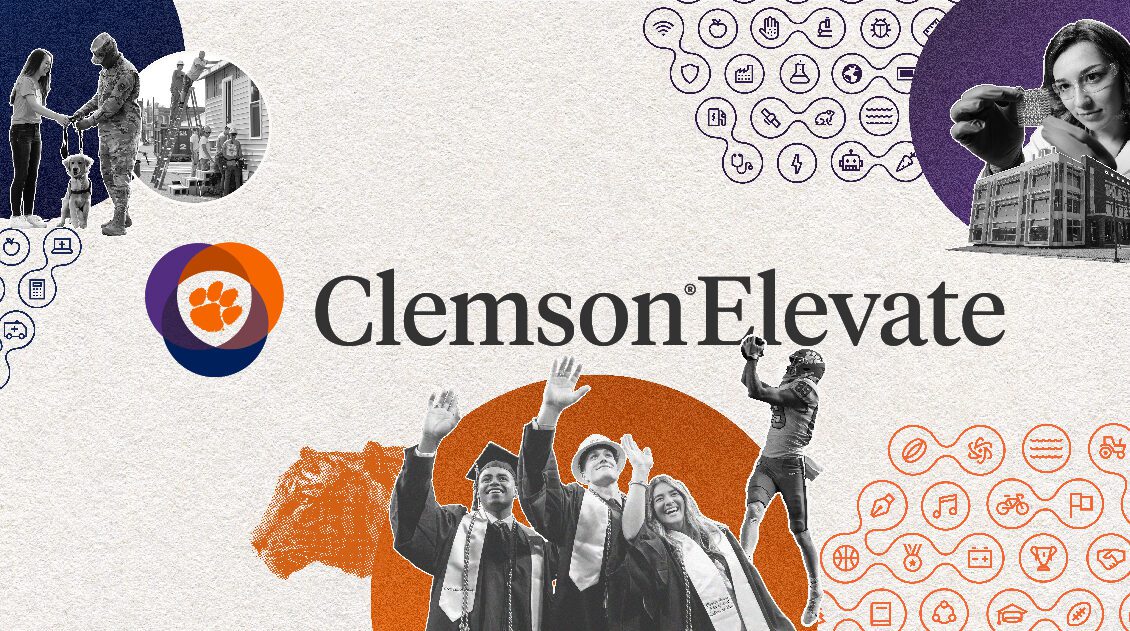Clemson Elevate, a bold new strategic vision for Clemson University, was introduced by University President Jim Clements and Executive Vice Presidents Bob Jones and Tony Wagner at an on-campus and virtual event on Thursday. The new strategic plan outlines pillars and actionable initiatives to build on the University’s strength and stature without losing sight of its commitment to the citizens of South Carolina and its land-grant mission.
“I am thrilled to present a bold strategic plan to achieve even greater heights of excellence for our beloved University and all whom we serve,” President Clements said.
“In the last decade, Clemson has set new records in student success, research, outreach, athletics, fundraising, industry partnerships, innovation and impact. Importantly, we attained this success while continuing to serve the needs of the citizens of South Carolina.”
President Clements
Clemson Elevate is a strategic plan to propel Clemson’s success and further strengthen its reputation. Led by guiding principles, criteria and analysis, more than 200 individuals representing all quarters of the institution identified key strategies for continued success, and through their participation, 15 areas of focus and excellence were defined.
- Academic success and experiential learning.
- AI/data science/cybersecurity.
- Human performance.
- Ecosystem/digital water.
- The Clemson Experience.
- Neuroscience to neuroengineering.
- Agricultural food systems and environmental resilience.
- Future of learning and work.
- Rural health initiatives.
- Precision medicine/human genomics.
- Emerging infectious diseases.
- Future advanced materials.
- Clinical facilities/care transformation.
- College of Veterinary Medicine.
- Energy transformation and advanced manufacturing.
From neuroscience and engineering, agricultural systems, environmental resilience and AI to precision medicine and care transformation, futuristic advanced materials, mobility and more, the rapid innovation of today demands a new approach in the coming years.
These key areas meld Clemson’s strengths with bold aspirations and opportunities for the University’s next chapter, and through them, three pillars emerged.
CORE STRATEGIC PILLARS
1. We will deliver the No. 1 student experience, core to our mission.
2. We will double research by 2035, working in collaboration with government and industry to advance scientific research and discovery.
3. We will transform lives, impacting the citizens of South Carolina and beyond through measurable health and economic development.
Each division, department and college across the University will focus on the three core strategic pillars, each backed by a series of initiatives and related metrics.
THE PROCESS
Starting in the spring of 2021, Clemson’s leadership initiated a deep analysis of progress toward some of the University’s most aspirational goals and took stock of the opportunities ahead.
Clemson’s COVID-19 response was hailed as a national example of operational effectiveness, transparency and impact. In responding to the pandemic, positive multidisciplinary collaborations emerged that prompted innovation and discoveries.
A planned refresh of the Clemson Forward strategy became a new strategy for a new era. While building on the precepts of the prior plan, Clemson Elevate adds emerging and divergent areas of strength and focus.
Clemson Elevate represents that new approach. The strategic plan will propel Clemson’s success and further strengthen its reputation over a 12-year implementation period.
“The implementation plan intentionally creates opportunities for the strategic pillars to build upon one another,” said Provost Jones. “Students who are engaged in undergraduate research experience transformational learning, contributing at once to their student experience, to research and discovery, and to solving real world problems that impact lives.”

